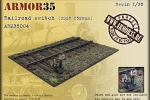1⁄35
Friday, February 22, 2013 - 05:49 AM UTC
Armor35 announces a switch in subjects with this 1/35 trackwork switch!
Armor35 has released several resin and mixed-media tangent track sets and end-of-track buffer stops. Now they are preparing a Soviet 5-foot gauge (1520 mm) switch for you to model a diverging tracks vignette. Included is a switchstand with lever, lighted target, and accompanying linkages. The trackwork sets upon a base that is wider than usual to accommodate the long crossties that support the switchstand.
No word yet whether the model will be multi-media or all resin.
Please remember to tell vendors and retailers that you saw this model here - on Armorama!
No word yet whether the model will be multi-media or all resin.
Please remember to tell vendors and retailers that you saw this model here - on Armorama!
Click Star to Rate
No one has rated this yet.
THIS STORY HAS BEEN READ 8,170 TIMES.
| Armor 35 Reviews | MORE |
| Soviet Ua Railcar by Frederick Boucher | of 1 ratings, 100% found this helpful | |
| Soviet Railway Boxcar by Frederick Boucher | of 1 ratings, 100% found this helpful | |
| NKVD Soldier by Frederick Boucher | of 1 ratings, 100% found this helpful | |
| ZIL-130 Front End by Frederick Boucher | of 1 ratings, 100% found this helpful | |
| Seven Cats by Frederick Boucher | of 1 ratings, 100% found this helpful | |
| Mongrel Dogs by Frederick Boucher | of 1 ratings, 100% found this helpful | |
| Fantasy Model Tank Girls by Todd Michalak | of 1 ratings, 100% found this helpful | |
| Soviet Flatcar by Frederick Boucher | of 1 ratings, 100% found this helpful | |
| Soviet Railroader On Duty by Frederick Boucher | of 2 ratings, 100% found this helpful | |
| Stalingrad Fountain by Frederick Boucher | of 1 ratings, 100% found this helpful | |
| Hairy Heads by Frederick Boucher | |
| Soviet Heads in Garrison Caps by Frederick Boucher | of 1 ratings, 100% found this helpful | |
| Figure Heads by Todd Michalak | of 1 ratings, 0% found this helpful | |
| Tank Girl by Todd Michalak | of 3 ratings, 67% found this helpful | |
| Bismarck Statue by Frederick Boucher | of 3 ratings, 67% found this helpful | |









Comments